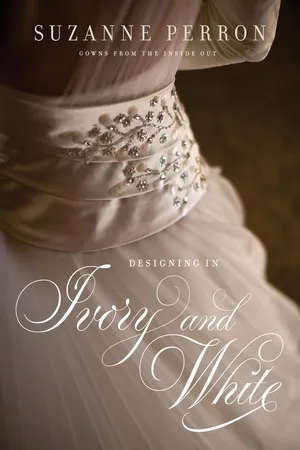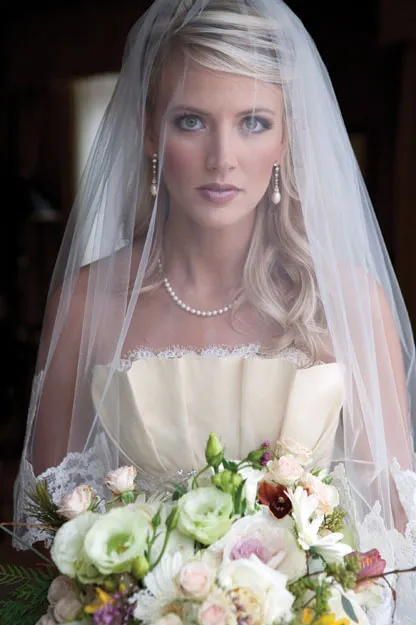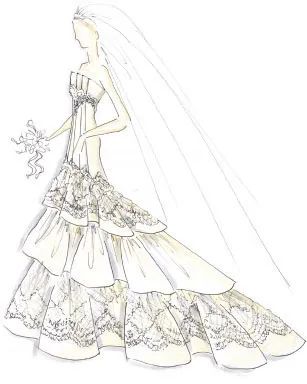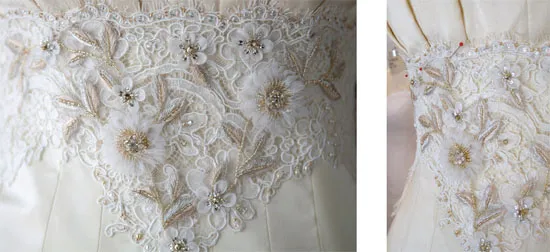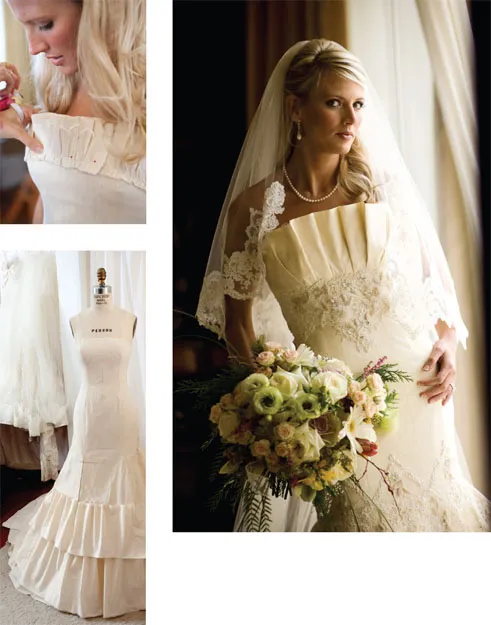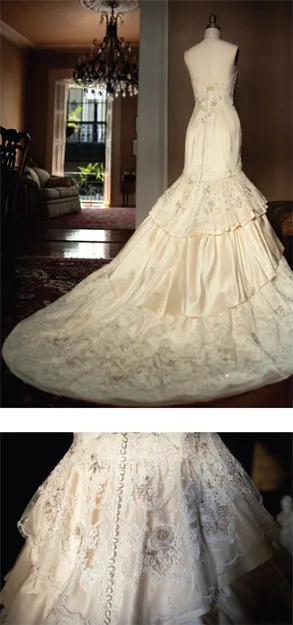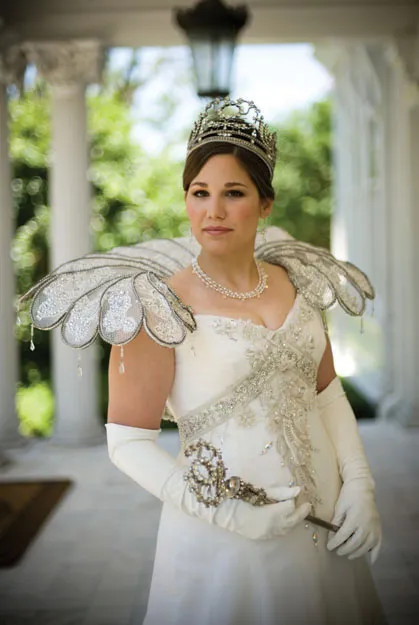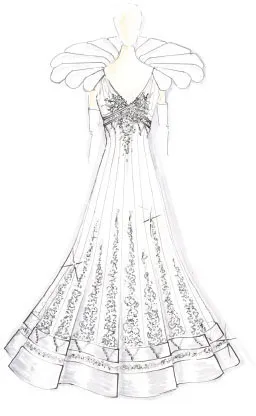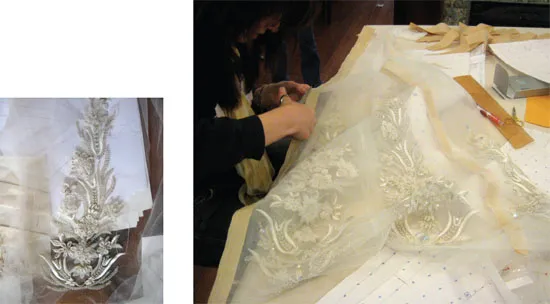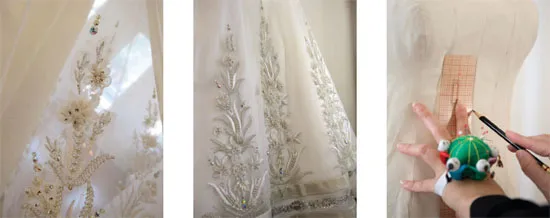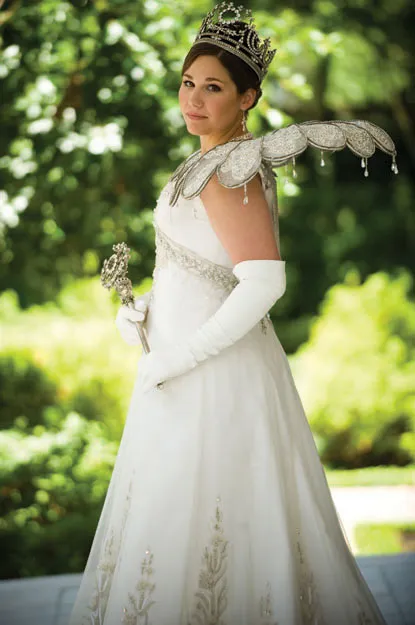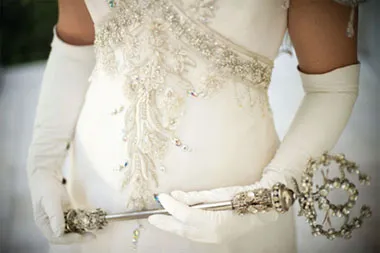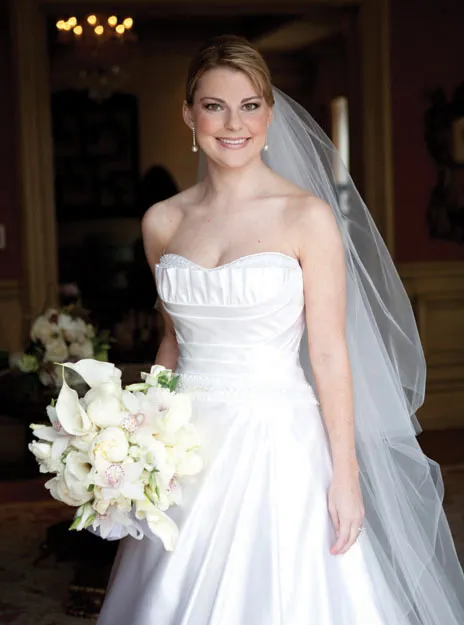![]()
The Gowns
OPPOSITE PAGE:
Pleated crumb catcher with lace peeking beyond (BB)
![]()
Jolie, Bride
Astatuesque bride dressed in golden hues of ivory commands the eye of far and near in a dramatic gown created to reflect her vision. A three-tiered skirt, an elaborate train, and a sinuous trumpet silhouette were part of that vision. Jolie was specific in every detail: the shape of the skirt, the hues in the beading, and the depth of the bodice pleating. Jolie’s gown was a true collaboration between client and designer.
The bodice is sculpted with a dozen vertical seams. The seams extend into deep pleats framing the neckline. Three perfectly shaped tiers are gathered below the knee and fall generously to the floor.
An exhaustive search of all of my fabric sources yielded three choices of dark ivory. One option was a rich silk double charmeuse. Another fabric in a dark ivory hue was a weighty duchess satin. The final option was a raw silk dupioni suggesting the hues and striations of corn silk. The last option prevailed. The raw silk offered the richness of color and desired lightness in weave conducive to the elaborate tiers of the skirt. Ivory lace plays beautifully against the color.
Sketch of Jolie’s gown
Two galloon laces with pronounced borders were combined to decorate the gown. An elaborate, wide Alençon lace with a large scallop repeat was of the perfect scale to work with the generous ruffles and expansive train. A more narrow scalloped lace with a smaller repeat was appliquéd around the empire line and knee seam. Peeking from behind the elongated pleats of the crumb catcher is yet another border of lace.
Light reflection was crucial to this creation. Hand-sewn crystals of golden shadow and crystal-transmission lochrosens accent the imported floral appliqués. Threads of gold and silver intertwine with beading to create vines of foliage accented by dimensional blossoms of tulle. Crystals cluster to make dimensional centers. Silk organza is shaped to create delicate petals. The scallops of the hem lace are further accented with golden shadow bicones and antiqueivory Swarovski pearls.
Dozens of silk-covered buttons finish the entire length of center back. The pleats of the front crumb catcher are repeated along the top of the back bodice. The back vertical seams allowed for the painstaking shaping of the sculpted silhouette.
The theme of three is repeated in the veil. Three tiers of illusion are individually adorned with unique borders of lace. The longest tier of the cathedral-length veil bears the most generous border and is adorned with crystals and elaborate floral embroidery.
CLOCKWISE:
Lace and sketches (BB)
Pinning lace ruffle (BB)
Appliquéing embroidery (SP)
Dimensional tulle flowers (SP)
CLOCKWISE:
Bodice ruffle detail (BB)
Shaped midriff with lace appliqué (JC)
Developing gown shape in muslin (BB)
Back train (JC)
First of three tiers (JC)
OPPOSITE PAGE:
Full-length silhouette (JC)
OPPOSITE PAGE:
Queen’s portrait (JC)
![]()
Jackye, Olympians Queen
Jackye reigned over the Krewe of Olympians, a Mardi Gras organization dating back to 1904. Jackye stepped gracefully into the long line of royalty wearing a traditional Medici collar and a couture gown of tulle and satin. The inspiration for the gown came from a magazine tear sheet of a wedding gown with vertical seams, an empire waist, and tulle straps. To elongate Jackye’s figure, the empire seam became an inverted V and tulle was draped to create an opposing V neckline. Silver was the adornment of choice as dictated by the organization’s dark navy mantle and train, encrusted with silver stones and appliqués.
Sixteen blocks of tulle were embroidered in India using the same resources available to the couture designers of New York’s fashion industry. Two different blocks of embroidery were developed. Each block was embroidered eight times. The embroidery consists of exquisite threadwork, bugle beads, pearls, rhinestones, and fabric-twisted flowers. The leaflike scrolls at the bottom of the embroidery resemble the leaf motif of the traditional Olympians mantle. When the blocks arrived back in the design studio, they were cut and sculpted to fit the pattern pieces coinciding with each panel of the gown body. The embroidery was positioned vertically through the center of each panel shaped like an elongated isosceles trapezoid. The two embroidery blocks were alternated to create a high-low effect.
Sketch of Jackye’s gown
The pattern for the gown was developed by flat pattern and drafting. A fitted muslin was completed before we decided on the placement of the vertical seams. We divided the circumference of the gown equally and penciled precise lines onto the muslin, giving a proportionate representation of the finished product. We transferred the lines to the paper pattern and developed the sixteen vertical panels for the body. The tulle bodice was created by draping on the mannequin. Once the appropriate look was achieved three-dimensionally, the tulle was marked and made into a paper pattern.
Sewing with fabric as delicate as tulle requires special handling. Strips of tissue paper were used as under paper when machine stitching. The tissue prevents the tulle from getting caught in the machine or from puckering under the presser foot. The seam allowance was also marked on the tissue for extreme accuracy. Seam allowance accuracy is crucial to a fitted garment with multiple seams. The smallest seam allowance variance over sixteen seams can yield a garment circumference being off by a few inches.
The assembled beaded tulle panels float over a duchess satin princess-seamed gown. Metallic bands encircle the hem and outline the empire waist. Silver lamé was veiled with gold mesh to blend with the antique silver of the organization’s mantle. Swarovski crystal lochrosens and navettes hand appliquéd in the design studio add shimmer. Bugle bead fringe finished with faceted crystal drops finish the empire line and hem with added sparkle.
CLOCKWISE:
Beading approval sample from India (SP)
Assembling tulle panels with tissue stays (CP)
Marking vertical seams on muslin (BB)
Alternating heights of beaded godets (JC)
Sheer embroidery base (SP)
OPPOSITE PAGE:
Side view (JC)
Back appliqué and tulle shoulder drape (JC)
Decorative empire band (JC)
Front beadwork (JC)
OPPOSITE PAGE:
Full-length silhouette (JC)
OPPOSITE PAGE:
Formal bridal portrait (BB)
![]()
Shelley, Bride
Shelley envisioned a gown of luxurious white satin adorned with subtle touches of pearls and beadwork. Her preference for a strapless ball gown with a full A-line skirt provided ideal parameters in which to work. Her coloring was most enhanced with white, not ivory. Her narrow waist was easily accentuated through draping. Her décolletage was be...
